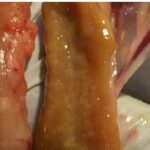
By Drs. Pat Brown, Ph.D., and Dave Jones, Ph.D.
The gastrointestinal tract (GI tract) marks the physical boundary between an animal and the contents of its intestines. This boundary allows direct contact between the immense surface area of the GI tract and the intestinal contents (digesta). The contents include a far-ranging mixture of undigested feed and feces, digestive secretions, parasites, microbial toxins, and microorganisms, all of which are separated from the intestine proper by a single layer of cells. This vast community of microorganisms is dominated by bacteria and is referred to as the gut flora or microbiota.
The microbiota, with bacterial and viral populations in the trillions and quadrillions, respectively, functions with the shared demands and metabolism of an organ. In essence, it operates as a distinct, separate organ within the GI tract. Over the last two decades, a compelling and mutually beneficial relationship between the commensal bacteria in the GI tract and the health and well-being of the host animal was identified by immunologists and microbiologists.
The digesta presents two challenges to the GI tract, both of which would appear to be incompatible with the other. On one hand, it must quickly reduce feed ingredients to water-soluble, absorbable nutrients, while, on the other, it must provide an impermeable barrier against colonization and penetration by pathogenic bacteria. Under appropriate conditions, pathogenic bacteria can overwhelm the GI tract and cause disease, but only if they first succeed in breaching this defensive barrier. In the progression of a disease, pathogenic bacteria do not suddenly become virulent. Rather, they are opportunistic residents of the GI tract, biding their time until conditions favor their overgrowth. This article will review the mechanisms employed by the microbiota in defending the intestine against colonization by pathogenic bacteria.
Most enteric pathogens are established residents of the GI tract, and their overgrowth is prevented by an array of protective mechanisms. These defense mechanisms are typically grouped into one of two categories. The first line of defense encompasses physical and chemical barriers to infection, while the second grouping includes components of the more complex immune-based defense system. Both systems rely on the beneficial community of commensal bacteria to maintain intestinal defense barriers. The protective and metabolic functions of the intestinal microbial community are listed in Table 1 (O’Hara and Shanahan, 2006).
Table 1. Protective and metabolic functions of the microbiota.

Microbiologists and immunologists agree that direct communication occurs between the microbial community and the immune system, such that each shapes the activity of the other. Agri-King’s microbiology group has demonstrated repeatedly, through research trials that feeding our symbiotic products Avi-Max to poultry and Tri-Lution® to swine, beef, and dairy cows produce a predictable and pronounced impact on the microbiota. Table 2 shows data from research that demonstrated suppression of enteric pathogens was significant in animals treated with Tri-Lution. By inference, a favorable shift in the microbiota implies a positive impact on the intestinal and systemic immune systems. The data represent a significant investment in time, to both collect the intestinal and fecal samples, as well as that required to culture and quantify the hundreds of samples represented therein. There are situations, however, where the effect of treatment is obvious, such that the response is readily apparent to an outside visitor. For example, pig producers and swine veterinarians have seen a marked response to the robust treatment protocols developed by Agri-King Regional Manager Justin Monson for feeding Tri-Lution to nursing pigs and pig nurseries. The “43-cc” scoop in the title of this article refers to feeding on farrowing-room litter mats with a daily scoop of Tri-Lution (Figure 1). While the numerical response to Tri-Lution was impressive in these trials, the visual response was unmistakable.
Table 2. Effect of Tri-Lution® treatment on the shedding of bacterial pathogens (cfu*/gram).

The effects of Tri-Lution on nursing pig performance were measured (Table 3) in research conducted by Monson at a farrow-to-wean farm. It should be emphasized that feeding Tri-Lution did not begin until after the pigs were born. Thus, Tri-Lution had no opportunity to influence the number of pigs born live in this trial. In litters fed Tri-Lution, the number of pigs weaned per litter was greater than in litters not fed Tri-Lution. This increase was supported by a decrease in pre-weaning mortality.
Table 3. Effect of Tri-Lution on the performance of health-stable nursing pigs.

One important observation that can be made from feeding Tri-Lution is that it may hasten the recovery from the adverse effects of the antibiotic intervention. It is now recognized that antibiotic use may cut a swath through the commensal microbiota, with a disrupted intestinal ecosystem being susceptible to secondary pathogens. Since Monson’s protocol recommends continuous feeding of Tri-Lution, without regard to antibiotic therapy, this strategy likely speeds recovery of the microbiota from the potentially adverse and long-lasting effects of an antibiotic.
The visual effect of Avi-Max on the pathology of broilers inoculated with Clostridia perfringens is illustrated in Figures 2 and 3. In this independent study, intestines from broilers treated with Avi-Max did not develop lesions characteristic of necrotic enteritis, while untreated birds in the same study developed clinical symptoms of the disease. The response to feeding Avi-Max was visual. This supports the performance response seen in these same birds.

Figure 2.
The majority of the bacteria living in non-ruminants are in the large intestine. In years past, the large intestine was considered a fermentation chamber whose principal function was to extract water from the digesta. Little attention was given to answering the questions “Why are there trillions of bacteria in the GI tract?” and “What exactly is their purpose?” Today, microbiologists and immunologists believe there is compelling evidence that the role of the gut microbial community extends far beyond that of being a participant in digestive physiology and intestinal defense: there is a fundamental connection between the health of these microbes and the well-being of the host
animal.
Figures 2 and 3, at right. Effect of feeding Tri-Lution on the pathology of intestines from broilers challenged with Clostridia perfringens. (Photographs and pathology report courtesy of Michael Sims, Virginia Diversified Research, LLC.)

Figure 3
Evidence for the relationship between the gut microbiota and the host animal has been demonstrated by Agri-King’s research group (Jones et al., 2002). A trial was conducted to determine if feeding Tri-Lution to pre-fresh cows for 3 weeks before calving would have an impact on immunoglobulin concentrations in colostrum. Table 3 shows the results of this trial.
Table 4. Immunoglobulin Titers (mg/100ml) in Colostrum after Tri-Lution supplementation.
This study demonstrated a greater amount of IgA in the colostrum when dairy cows were fed Tri-Lution 3 weeks pre-partum compared to pre-fresh dairy cows fed the same diet without supplemental Tri-Lution.
Overall, the microbiota of the GI tract is important to livestock beyond the role of digestion. Research has suggested that supplementing poultry, swine, dairy and beef diets with Avi-Max or Tri-Lution may have a positive impact on gut microbiota and, therefore, have a beneficial effect on livestock. AK